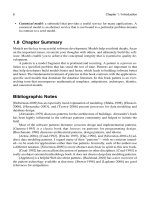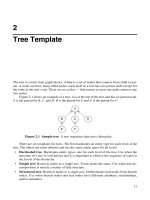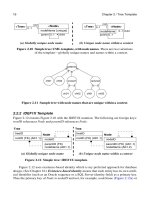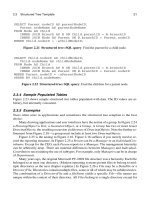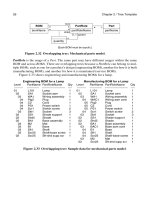PATTERNS OF DATA MODELING- P25 docx
Bạn đang xem bản rút gọn của tài liệu. Xem và tải ngay bản đầy đủ của tài liệu tại đây (150.16 KB, 5 trang )
8.5 Excessive Generalization Antipattern 103
8.5 Excessive Generalization Antipattern
8.5.1 Observation
A model has a deep generalization. In many cases extensive taxonomies are motivated by
object-oriented programming and are inadvisable.
8.5.2 Except ion s
If there is a formal standard for a taxonomy (such as for biological organisms) you should
use it. Otherwise I cannot think of a justification. Normally, it is best to avoid deep general-
ization.
As an example, [Americazoo] presents a taxonomy for mammals, including Figure 8.8
for wolves. Each indentation is a lower level in the taxonomy. Figure 8.8 corresponds to a
generalization that is seven levels deep.
8.5.3 Resol ution
As a guideline a database taxonomy should be no more than four levels deep. (A program-
ming taxonomy should be no more than five levels deep.)
8.5.4 Examples
Many years ago at GE Global Research, we built a software modeling tool, called OMTool.
The tool was based on a metamodel with a taxonomy that was seven levels deep. Even
though the taxonomy was sound, we found it difficult to remember all the levels complicat-
ing development. In retrospect we regretted using such a deep taxonomy.
On another project we prepared a large equipment taxonomy (50 pages long!). [Blaha-
2003] We understood the problem well and had access to domain experts. Nevertheless, we
had trouble with modeling. The taxonomy was so extensive that it was difficult to determine
where to place equipment. Also the various types of equipment had many fields and we kept
discovering additional data. For this project, it would have been better to forego a hardcoded
taxonomy and instead use a softcoding approach. [Blaha-2006]
Section 10.2 shows a sound taxonomy that is three levels deep.
Class: Mammalia
Subclass: Theria
Infraclass: Eutheria
Order: Carnivora
Family: Canidae
Genus: Canis
Species: lupus
Figure 8.8 Excessive generalization: Taxonomy for wolves. Normally it is
best to avoid deep generalization; formal standards are an exception.
104 Chapter 8 / Universal Antipatterns
8.6 Disconnected Entity Types Antipattern
8.6.1 Observation
A model has a number of free-standing entity types. From the problem understanding, it
would seem that they should be related.
8.6.2 Except ion s
Some disconnected entity types can be acceptable (as a guideline, no more than 10% of the
entity types). But it is suspicious when a model has many of them.
8.6.3 Resol ution
Recognize that the model is likely to be incomplete. Determine the missing relationships and
add them.
8.6.4 Example
Many Eclipse (www.eclipse.org) applications generate XML files for storing persistent data.
An application may also have a database that developers populate apart from Eclipse. If you
reverse engineer the database, the resulting model can appear to be incomplete. Ideally the
database should store both the added data and the Eclipse data.
8.7 Modeling Errors Antipattern
8.7.1 Observations
A model has one or more serious conceptual flaws. Modeling errors lead to bugs in the fin-
ished software, complicate development and maintenance, and can impair performance.
8.7.2 Except ion s
Errors in models become errors in the finished software. Errors are never acceptable, but
sometimes you have to live with them, such as with legacy systems and vendor software.
8.7.3 Resol ution
Understand the flaw and how it may have come about. If possible, correct the model.
8.7.4 Examples
Over the years I have reverse engineered several modeling tools and inspected their internal
metamodels. One would expect tool developers to have excellent models, but that is not al-
ways the case. Some data modeling tools have the deep flaw of directed relationships.
As Figure 8.9 shows, a directed relationship has “from” and “to” entity types. Using
such a tool to construct Figure 8.1b, Contract would be “from” and ContractRelationship
8.8 Multiple Inheritance Antipattern 105
would be “to” or vice versa. This is nonsense. The model simply states that Contract and
ContractRelationship are related. An improved model (Figure 8.9b) introduces the notion of
a role which is the intersection of an entity type and a relationship. As a side benefit, the im-
proved model can support ternary relationships.
For another example, I reverse engineered a vendor product for a library catalog system
and found that the database implemented a linked list. There is no such thing as a “linked
list” in a conceptual model of a library. Someone did not abstract properly and misguidedly
put implementation concepts in a conceptual model.
8.8 Multiple Inheritance Antipattern
8.8.1 Observation
A model has multiple inheritance. Multiple inheritance is a generalization for which an
entity type inherits information from multiple supertypes.
8.8.2 Except ion s
Multiple inheritance is not appropriate for data models. It can be acceptable as a mechanism
for programming reuse and for other kinds of models.
8.8.3 Resolutions
Avoid multiple inheritance in data models. Degrade the model if necessary. There is no clean
way to implement multiple inheritance with a database. In practice I have found that multiple
inheritance seldom occurs with databases and is not worth the bother.
8.8.4 Example
In Figure 8.10a and Figure 8.11a FullTimeUnionEmployee is both FullTimeEmployee and
UnionEmployee. The model does not show it, but an extended model could define three ad-
ditional combinations: FullTimeNonUnionEmployee, PartTimeUnionEmployee, and Part-
TimeNonUnionEmployee. Figure 8.10b and Figure 8.11b use a workaround (others are
possible) to eliminate the multiple inheritance.
Figure 8.9 Modeling error: UML relationship model. Repair modeling errors.
EntityType Relationship
fromEntityType
toEntityType
EntityType
Relationship
Role
(a) Antipattern example (b) Improved model
*
*
1
1
*
*
1
1
106 Chapter 8 / Universal Antipatterns
8.9 Paradigm Degradation Antipattern
8.9.1 Observation
A relational database is degraded to fit some other paradigm.
8.9.2 Except ion s
Such a technique is highly questionable.
8.9.3 Resol ution
Rework the model and architecture to avoid such degradation.
8.9.4 Examples
Many years ago, I was reverse engineering the database of a commercial product and was
perplexed. The resulting model had many disconnected entity types with only a smattering
of relationships. I could not understand how so much information could be missing and sus-
pected that many relationships were disguised. I decided to cross check the schema with the
employmentStatus unionStatus
Figure 8.10 Multiple inheritance: UML employee model. Avoid multi-
ple inheritance in conceptual data models.
UnionPartTim eFullTime
FullTimeUnionEmployee
Employee Employee Employee
Employee
(a) Antipattern example
unionStatusemploymentStatus
Em ployeeUnionDataEmployee
11
(b) Improved model
(workaround)
FullTime
Employee
PartTime
Employee
Union
Employee
Nonunion
Employee
Nonunion
Employee
8.9 Paradigm Degradation Antipattern 107
hierarchical screen layout and discovered the missing relationships. The software vendor
confirmed my understanding.
The product supported a fixed hierarchy of depth three. Apparently the vendor created
the original product with a proprietary hierarchical database. Then the vendor migrated to
client-server technology and devised an isomorphic hierarchical database using a relational
database for the server. Figure 8.12 shows the structure for level 1, 2, and 3 tables. The point-
er fields are hidden parent pointers.
unionEmpID (FK)
employmentStatus
FullTimeEmployee
fullTimeEmpID (FK)
PartTimeEmployee
partTimeEmpID (FK)
Figure 8.11 Multiple inheritance: IDEF1X employee model.
unionStatus
UnionEmployee NonunionEmployee
nonunionEmpID (FK)
employeeID
Employee
employmentStatus
unionStatus
(b) Improved model (workaround)
(a) Antipattern example
unionEmpID (FK)
employmentStatus
FullTimeEmployee
fullTimeEmpID (FK)
PartTimeEmployee
partTimeEmpID (FK)
unionStatus
UnionEmployee NonunionEmployee
nonunionEmpID (FK)
employeeID
Employee
employmentStatus
employeeUnionDataID
EmployeeUnionData
unionStatus
employeeID (FK) (AK1.1)
FullTimeUnionEmployee
fullTimeEmpID (FK)
nonunionEmpID (FK)



